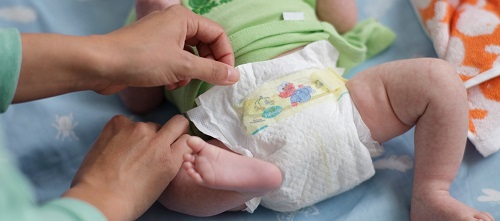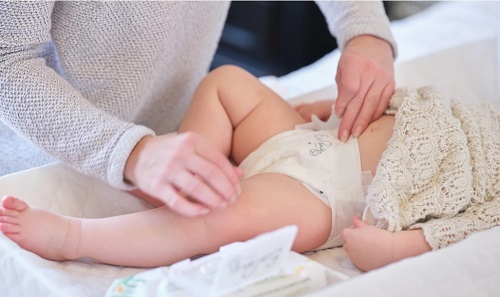Ensuring that diapers fit newborns correctly is essential for your baby’s comfort, health, and well-being. The right fit can prevent leaks, reduce the risk of diaper rash, and keep your newborn happy throughout the day. A well-fitted diaper allows for free movement and doesn’t irritate sensitive skin. Parents often find themselves overwhelmed when selecting the right diaper size, especially with so many brands and sizes on the market. However, the fit of the diaper is just as important as its absorbency. Finding the right balance between snugness and flexibility ensures maximum comfort for your newborn. In this guide, we will explain how are diapers supposed to fit newborns to provide the best comfort, covering the importance of proper fit, step-by-step tips for choosing the right size, and common mistakes to avoid. Following these simple guidelines will help ensure your baby is comfortable and dry.

Why Is the Right Fit Important for Your Newborn’s Comfort?
The correct diaper fit is crucial for a newborn’s overall comfort and health. If a diaper is too loose, it may not contain messes, leading to leaks and more frequent changes, which can irritate your baby’s skin. On the other hand, a diaper that is too tight can restrict movement, cause discomfort, and lead to chafing or rashes around the waist and thighs. A diaper that fits well ensures your newborn stays dry for longer periods, helping prevent diaper rash, which is often caused by prolonged exposure to moisture. Additionally, the right fit allows the baby to move freely without feeling restricted or uncomfortable. Ensuring the proper fit also contributes to better sleep and less fussiness, as the baby remains comfortable throughout the night.
How to Choose the Right Size Diaper for My Newborn?
Finding the correct diaper size for your newborn can feel overwhelming. The size you choose should accommodate your baby’s growth while ensuring comfort. Let’s dive into the steps for choosing the perfect size diaper.
Step 1: Know Your Newborn’s Weight
The first and most crucial step in selecting the right diaper size is knowing your newborn’s current weight. Most diaper brands categorize their diaper sizes based on the baby’s weight, with specific recommendations for newborns typically ranging up to 10 pounds. Therefore, weighing your baby frequently helps ensure you’re using the correct size diaper. If your baby is close to the upper limit of the diaper’s weight range, you may need to size up to prevent tightness and discomfort. On the other hand, if your baby is on the smaller side, choosing a diaper size too large could result in gaps, leaks, and reduced protection. Therefore, always monitor your baby’s weight, especially during growth spurts, to keep up with their changing diaper needs.
Step 2: Check for a Snug but Not Tight Waistband
Once you’ve selected the diaper size based on weight, the next step is to ensure the waistband is snug but not tight. A properly fitted waistband should rest just below the baby’s belly button and fit securely around the waist without digging into the skin. You should be able to comfortably insert two fingers between the waistband and your baby’s stomach. If the waistband is too tight, it could cause indentations and discomfort for your baby, making them fussy or irritable. Conversely, a loose waistband may lead to gaps that cause leaks, especially during naps or long periods of wear. Make sure to adjust the diaper properly each time you change your newborn to ensure the waistband is sitting correctly and providing adequate support without being restrictive.
Step 3: Inspect the Leg Cuffs for Gaps
The leg cuffs of the diaper are designed to prevent leaks by creating a snug seal around your baby’s legs. When putting on a diaper, check to ensure there are no gaps between the leg cuffs and your newborn’s thighs. The cuffs should lie flat without being tucked inside, as this could allow liquid to escape. If you notice gaps, this may indicate that the diaper is too large, and you might need to size down to ensure a better fit. On the other hand, if the leg cuffs leave red marks or cause irritation, the diaper may be too small. Gently adjust the diaper by running your fingers around the leg cuffs after putting it on to make sure they are properly positioned to prevent leaks and provide a comfortable fit.
Step 4: Look for Signs of Leaks or Irritation
After securing the diaper, it’s important to keep an eye out for signs of leaks or skin irritation. If you find that your newborn is experiencing frequent leaks, it may be a sign that the diaper size or brand is not the right fit. Similarly, red marks around the waist or legs, or signs of chafing, indicate that the diaper may be too tight. Frequent leaks or irritation can also suggest that the diaper’s absorbency is insufficient for your newborn’s needs. In this case, trying a different size or switching to a more absorbent brand might help resolve the issue. Always check your baby’s skin after diaper changes for signs of redness or discomfort, and adjust the diaper size or fit as needed to maintain their comfort and prevent leaks.

Common Mistakes Parents Make with Diaper Fit
Many new parents struggle with diaper fit, leading to discomfort for their baby and unnecessary frustration. One of the most common mistakes is choosing a diaper size that’s too small. A diaper that’s too tight can restrict movement and cause irritation or rashes. If you see red marks or indentations on your baby’s skin, the diaper is likely too small. Another mistake is not securing the diaper properly. A diaper that’s too loose can lead to leaks and blowouts, especially around the legs and waist. Make sure the diaper is adjusted snugly, with no gaps or sagging, and double-check that the leg cuffs are positioned correctly. Finally, some parents overlook the importance of frequently sizing up as their baby grows. Newborns grow quickly, so staying attentive to weight changes is key to avoiding improper fit and ensuring maximum comfort.
Conclusion
Choosing the right diaper fit for your newborn is essential to their overall comfort and well-being. Understanding how are diapers supposed to fit helps prevent leaks, rashes, and irritation, all while ensuring your baby feels comfortable throughout the day. By choosing the correct size based on your baby’s weight, securing the waistband snugly, and checking the leg cuffs for gaps, you can avoid common issues like leaks and chafing. Pay attention to any signs of discomfort or irritation, such as red marks or frequent leaks, and adjust the diaper size or fit accordingly. With proper care and attention to how diapers are supposed to fit, you can help your newborn stay dry, comfortable, and happy. Remember, a happy baby is a comfortable baby, and a well-fitted diaper plays a big role in that.
FAQs:
1.How tight should a newborn’s diaper be?
A newborn’s diaper should be snug but not too tight. You should be able to comfortably slide two fingers between the waistband and your baby’s belly. If you see red marks or indentations on your baby’s skin, the diaper is likely too tight.
2.How often should I change my newborn’s diaper to avoid discomfort?
It’s recommended to change a newborn’s diaper every 2 to 3 hours or as soon as it becomes wet or soiled. Frequent changes help prevent diaper rash and keep your baby comfortable, as prolonged exposure to moisture can cause skin irritation.
3.Can the wrong diaper size cause rashes or irritation?
Yes, using the wrong diaper size can lead to skin rashes, irritation, and discomfort. Diapers that are too tight may chafe your baby’s sensitive skin, while diapers that are too loose can cause leaks, which may result in prolonged exposure to moisture and lead to diaper rash.
